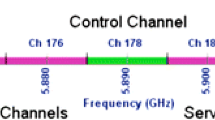Abstract
In vehicular environment, signal transmissions face more challenges than in indoor wireless local area systems. In such an unpredictable communication environment, multipath fading causes high bit error rate, which leads to higher dropping probability of packets. In order to reduce the dropping probability of handshaking packets without increasing the infrastructure capability, we propose to modify the traditional cyclic prefix into a variable cyclic prefix (VCP) of request-to-send and clear-to-send frames. By reducing the handshaking packet error rates, we improve the contention ability in carrier sense multiple access with collision avoidance scheme in vehicle-to-infrastructure transmission. Suitable VCP time slots and dynamically adjustable VCPs are predicted based on the analysis of appropriate environmental parameters.
















Similar content being viewed by others
Explore related subjects
Discover the latest articles and news from researchers in related subjects, suggested using machine learning.References
IEEE Std 1609.3-2010. (2010). IEEE standard for wireless access in vehicular environments (WAVE)—Networking services, pp. 1–212.
Kapp, S. (2002). 802.11a more bandwidth without the wires. IEEE Internet Computing, 6(4), 75–79.
IEEE Standard for Information technology—Telecommunications and information exchange between systems-local and metropolitan area networks-specific requirements. Part 11: Wireless LAN medium access control (MAC) and physical layer (PHY) specifications, IEEE Std 802.11 revision, 2007.
Bianchi, G, (2000). Performance analysis of the IEEE 802.11 distributed coordination function. IEEE Journal on selected areas in communications, 18(3), 535–547.
Zuquete, A. (2008). Improved CSMA/CA protocol for IEEE 802.11. Next generation internet networks, 2008. (NGI 2008), April 2008.
Manshaei, M. H., Cantieni, G. R., Barakat, C., & Turletti, T. ( 2005). Performance analysis of the IEEE 802.11 MAC and physical layer protocol. In Sixth IEEE international symposium world of wireless mobile and multimedia networks, 2005, (WoWMoM 2005), pp. 88–97.
Wen, J.-H., Lee, S.-H., Lee, G.-R., & Chang, J.-T. (2008). Timing and delay spread estimation scheme in OFDM systems. IEEE Transactions on Consumer Electronics, 54(2), 316–320.
Lin, Y.-P., & Phoong, S.-M. (2003). BER minimized OFDM systems with channel independent precoders. IEEE Transactions on Signal Processing, 51(9), 2369–2380.
Ayadi, M., Khedher, H., & Tabbane, S. (2005). BER simulation for WLAN networks in realistic environment. In 12th IEEE international conference electronics, circuits and systems, 2005 (ICECS 2005), pp. 1–5, December 11–14, 2005.
Martin, R. K., Ysebaert, G., & Vanbleu, K. (2007). Bit error rate minimizing channel shortening equalizers for cyclic prefixed systems. IEEE Transactions on Signal Processing, 55(6), 2605–2616.
Stuber, G. L. (2001). Principles of mobile communication. Dordrecht: Kluwer.
Jakes, W. C. (Ed.). (1974). Microwave mobile communications. New York: Wiley.
DRAFT standard for local and metropolitan area networks part 16: Air interface for broadband wireless access systems (revision of IEEE Std 802.16-2004 and consolidates material from IEEE Std 802.16e-2005, IEEE Std 802.16-2004/Cor1-2005, IEEE Std 802.16f-2005 and IEEE Std 802.16g-2007) P802.16Rev2/D7, October, 2008.
Henkel, W., Taubock, G., Odling, P., Borjesson, P. O., & Petersson, N. (2002). The cyclic prefix of OFDM/DMT-analysis. In Broadband communications, 2002, access, transmission, networking. 2002 international Zurich, seminar, pp. 22-1–22-3, February 19–21, 2002.
Hou, J., Smee, J. E., Pfister, H. D., & Tomasin, S. (2006). Implementing interference cancellation to increase the EV-DO Rev a reverse link capacity. IEEE Communications Magazine, 44(2), 58–64.
Bhattacharyya, B., Misra, I. S., & Sanyal, S. K. (2011). Optimization of error performance in a WiMAX transceiver using novel adaptive cyclic prefix strategy, 2011. In 14th international conference on computer and information technology (ICCIT), pp. 245–250, December 2011.
Bakker, J. D. (2002). Eliminating the OFDM cyclic prefix personal, indoor and mobile radio communications. In The 13th IEEE international symposium (Vol. 2, pp. 834–837), September 15–18, 2002.
Tang, T., & Heath, R. W., Jr. (2005). Space-time interference cancellation in MIMO-OFDM systems. IEEE Transactions on Vehicular Technology, 54(5), 1802–1816.
Pahlavan, K., & Levesque, A. H. (1995). Wireless information networks. New York: Wiley.
Huang, Y., & Rao, B. D. (2012). Awareness of channel statistics for slow cyclic prefix adaptation in an OFDMA system. IEEE Wireless Communications Letters, 1(4), 332–335.
Tsiftsis, T. A. (2011). On the performance of cyclic prefix-based single-carrier cooperative diversity systems with best relay selection. IEEE Transactions on Wireless Communications, 10(4), 1269–1279.
3rd Generation Partnership Project. (2008). Technical specification group radio access networks; deployment aspects (release 8). Technical report 3GPP TR 25.943 V8.0.0, December 2008.
Acknowledgments
Our gratitude goes to Hung-Lin Chan for discussion about some issues of this paper.
Author information
Authors and Affiliations
Corresponding author
Rights and permissions
About this article
Cite this article
Wu, TY., Anpalagan, A., Lee, WT. et al. Variable Cyclic Prefix for Contention-Based Wireless Access in OFDM-Based Vehicular Communication Systems. Wireless Pers Commun 77, 1905–1922 (2014). https://doi.org/10.1007/s11277-014-1615-4
Published:
Issue Date:
DOI: https://doi.org/10.1007/s11277-014-1615-4




